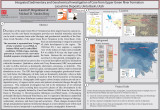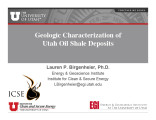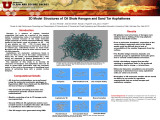TO
Filters: Collection: "ir_eua"
| Title | Date | Subject | Description | ||
|---|---|---|---|---|---|
| 1 |
 |
Getting from here to there: Devising an optimal regulatory model for CO2 transport in a new carbon capture and sequestration industry | 2010 | regulatory model for CO2 transport; new carbon capture and sequestration; CCS; regulatory model | If CCS is to become a broad-scale commercial industry in time to meet the need for climate change mitigation, the United States must adopt a regulatory model that will allow for efficient construction of critical infrastructure. A well-crafted regulatory framework gives private would-be CCS operator... |
| 2 |
 |
Water for commercial oil shale development in Utah: Allocating scarce resources and the search for new sources of supply | 2010 | commercial oil shale development; allocating resources; oil shale; bitumen | BACKGROUND A. What Is Oil Shale and Why Do We Care? Oil shale is a sedimentary rock containing solid bituminous materials. When oil shale is heated, petroleum-like liquids and gasses are released. The process of heating shale and capturing resulting liquids and gasses is called retorting and can occ... |
| 3 |
 |
Publications requirements | 2010 | ||
| 4 |
 |
Age and sex population projections for Utah conunties: 1975-2010. (Low Medium Projection) | 2010 | ||
| 5 |
 |
Age and sex population projections for Utah conunties: 1975-2010. (Low Projection) | 2010 | ||
| 6 |
 |
Age and sex population projection for Utah counties: 1975-2010 (High medium Projection) | 2010 | ||
| 7 |
 |
Staff Council award templates 2010-2014 (UUSAC) | 2010 | Member service; University of Utah employees | Template for service awards to members of the University of Utah Staff Council. |
| 8 |
 |
List of SERDP publications and presentations | 2010 | SERDP; SERDP publications; SERDP presentations | Bibliography of SERDP publications |
| 9 |
 |
Carbon dioxide sequestration: Effect of the presence of sulfur dioxide on the mineralogical reactions and on the injectivity of CO2+SO2 mixtures | 2010-01 | Carbon dioxide sequestration; CO2; Sequestration stream; Gas injection; CO2+SO2 mixture; Brine; Arkose; Calcite; Anhydrite; Calcium carbonate; CaCO3; Ankerite; Absolute permeabilities; Free-gas; Dissolved gas distribution; Saline formation; Contaminant gases; sulfur dioxide; SO2; Hydrogen sulfide; H... | This report presents experimental and modeling data on certain aspects of carbon dioxide (CO2) sequestration. As different processes are developed and implemented to facilitate the capture of CO2, other contaminant gases (sulfur dioxide, hydrogen sulfide and ammonia) may be present in the sequestrat... |
| 10 |
 |
A unified approach to the various formulations of the one-dimensional-turbulence model | 2010-01 | One-Dimensional Turbulence model; ODT; Stand-alone ODT models; Predicting turbulence statistics; Nonreacting flows; Reacting flows; Governing equations; Turbulent flow field; Linear Eddy Model; Eddy events | The One-Dimensional Turbulence (ODT) model has been successfully applied as a stand-alone model for predicting turbulence statistics in both nonreacting and reacting flows. There are several formulations of the model in the literature, and most of the variable-density formulations do not clearly dis... |
| 11 |
 |
Quarterly Progress Report Phase II: Clean and Secure Energy from Coal Project Period October 1, 2009 to December 31, 2009 | 2010-01-30 | domestic coal resources; capture CO2 from combustion; stationary power generation; oxy-coal flames; one-dimensional turbulence; ODT. | On September 14, 2009, Modification #001 was executed to renew the project for an additional Budget Period as a result of FY-09 Congressional Direction and funding. As part of this modification, the project was re-aligned to support only NETL's Strategic Center for Coal (SCC) program moving forward.... |
| 12 |
 |
Phase 2: Clean and secure energy from coal: Quarterly progress report: October 1, 2009 to December 31, 2009 | 2010-01-30 | domestic coal resources; CO2 capture; stationary power generation; oxy-coal flames; coal gasification process | The University of Utah is pursuing research to utilize the vast energy stored in our domestic coal resources and to do so in a manner that will capture CO2 from combustion from stationary power generation. The research is organized around the theme of validation and uncertainty quantification throug... |
| 13 |
 |
Utah Heavy Oil Program - Final Scientific/Technical Report - Project Period: June 21, 2006 to October 20, 2009 | 2010-01-31 | Utah heavy oil program; heavy oil; UHOP; developing heavy oil resources; oil sands resources; oil shale resources | The Utah Heavy Oil Program (UHOP) was established in June 2006 to provide multidisciplinary research support to federal and state constituents for addressing the wide‐ranging issues surrounding the creation of an industry for unconventional oil production in the United States. Additionally, UHOP w... |
| 14 |
 |
Clean and secure energy from domestic oil shale and oil sands resources: Quarterly progress report: October 2009 to December 2009 | 2010-02-03 | ICSE; Clean and Secure Energy program; CASE; Itasca Group; Red Leaf Resources; Enshale's; Vernal, Utah; oxy-fuel; CO2 capture; Oil shale; Oil sands; Crude oil; CO2 emissions; International Flame Research Foundation; Pyrolysis; Lattice Boltzmann; Kerogen; Oil recovery simulation; TGA; Dry shale; Pyro... | The Clean and Secure Energy from Domestic Oil Shale and Oil Sands Resources program is part of the research agenda of the Institute for Clean and Secure Energy (ICSE) at the University of Utah. The program was officially launched on October 1, 2009. The project management plan was submitted for revi... |
| 15 |
 |
Policy analysis of water availability and use issues for domestic oil shale and oil sands development: Topical Report: October 1, 2009 to March 31, 2010 | 2010-03 | oil shale/sands resources; energy source; unconventional fuels; water demands; water availability; domestic oil shale/sands development; topical report | Oil shale and oil sands resources located within the intermountain west represent a vast, and as of yet, commercially untapped source of energy. Development will require water, and demand for scarce water resources stands at the front of a long list of barriers to commercialization. Water requiremen... |
| 16 |
 |
Pore scale analysis of oil sand/oil shale pyrolysis by X-ray Micro CT and LB simulation | 2010-03-03 | pore scale analysis; oil sand/shale pyrolysis; X-ray Micro CT and LB simulation; Lamellar Structure of Oil Shale | The research objectives include (1) CT characterization of the pore network structure for selected oil sand/oil shale resources, (2) LB simulation of flow through pore network structures to predict transport properties, such as permeability, and (3) CT analysis of pore network structure during pyrol... |
| 17 |
 |
Integrated sedimentary and geochemical investigation of core form the upper Green River Formation lacustrine deposits, Uinta Basin, Utah | 2010-04-12 | upper Green River formation; lacustrine deposits; geochemical investigation; lithofacies; facies | Description of the upper Green River Formation has been largely based on outcrop exposures, but this core-based investigation provides newly detailed subsurface data that can be used to examine basin-wide lithologic and geochemical variability of he Parachute Creek Member of the upper Green River Fo... |
| 18 |
 |
Geologic characterization of Utah oil shale deposits | 2010-04-28 | oil shale development; geologic framework; lake evolution; oil shale; stratigraphic correlation | Why Geology? Economic prospectivity of oil shale development in the Uinta Basin relies heavily on establishing a solid geologic framework. Understanding lake evolution matters. |
| 19 |
 |
Utah energy: Perspective on unconventional fuels development | 2010-04-28 | Utah energy; oil shale basins; unconventional fuels. | Utah energy goals: 1) Affordable energy 2) Sustainable economy 3) Strengthen energy security and independence 4) Reduce emissions |
| 20 |
 |
Atomistic modeling of oil shale kerogen and asphaltenes | 2010-04-28 | Kerogen is a mixture of organic chemical compounds that make up a portion of the organic matter in sedimentary rocks. It is insoluble in normal organic solvents because of the large molecular weight (upwards of several thousand Daltons). When heated in the Earth's crust (oil window ca. 60 ° - 120 �... | |
| 21 |
 |
Clean and secure energy from Utah's oil shale and oil sands resources: Environmental, legal and policy framework | 2010-04-28 | ICSE; Land use; Water availability; Produced water; Utah; Colorado; Colorado River | This poster addresses major challenges to land use, water availability, and produced water. |
| 22 |
 |
Federal control of greenhouse gas emissions | 2010-04-28 | greenhouse gas emissions; federal control efforts; domestic legislation | Federal Control Efforts: 1) International 2) New Domestic Legislation 3) Using Existing Domestic Legislation |
| 23 |
 |
Environmental impact of the oil sands development | 2010-04-28 | unconventional fuels conference; unconventional fuels; environmental impact; oil sands development; bitumen production; oil sands; bitumen extraction; oil sands mining; global significance of oil sand resources | This presentation goes over an introduction to oil sands production and extraction, greenhouse gases, water, land disturbance, tailings, and reclamation. This presentation was given at the 2010 Unconventional Fuels Conference: Production of Fuels from Oil Shale, Oil Sands, and Coal. |
| 24 |
 |
Unconventional fuels market assessment | 2010-04-28 | ||
| 25 |
 |
Oxy-gas process heaters for efficient CO2 capture | 2010-04-28 | oil shale and oil sands technology; greenhouse gas emissions; GHG; large eddy simulation; LES; IFRF OXYFLAM | Implementation of oil shale/sands technologies in U.S. will require mitigation of greenhouse gas (GHG) emissions. |
